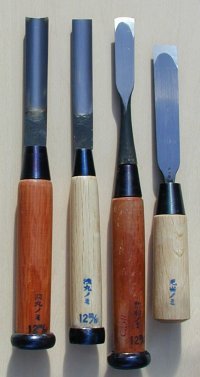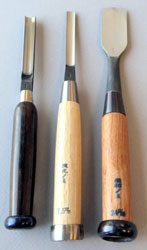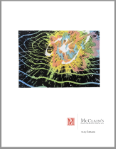
Moku Hanga Nomi - From left to right:
Fukagata Maru Nomi,
Asagata Maru Nomi,
Soai Nomi,
Kento Nomi

Nomi are coming with a number of different handle styles now so do not be surprised if the tool you receive does not look like the one in the photo. The blades have not changed. Thank you for your understanding.
The blades on all the nomi are made of the highest quality steel, while the handles are lacquered kashi (Japanese oak), the strongest and most durable wood growing in Japan.
The Kento Nomi is used to make registration notches, and the handle on this tool is designed for use by hand, and not for use with a mallet. The length is about 6 inches.
The Maru Nomi and Soai Nomi have metal ferrules at the end of the handle, and are designed for use with a kizuchi, or wooden mallet. The metal rings prevent the wood handle from splitting when the nomi are tapped with a mallet. Many people also cut by hand with these tools. They are all around 8 inches long.
Maru and Soai Nomi are excellent for clearing large areas on the block with speed and efficiency. While they resemble carpentry tools in appearance, they have been modified to perform the exacting maneuvers necessary for cutting on a flat, horizontal surface.
For example, looking at the side of the Soai Nomi, notice that
the blade and the shank gently taper in one long line towards
the tip, a design that keeps the tool thin and light yet strong.
The bevel is shallow, allowing the carver to comfortably push
the tool through wood that is sitting flat on the table. The
Soai Nomi has an arced tip or "bull nose" cutting
edge unique to the Japanese chisel. In the course of creating
this arc, the cutting edge is curved and the sharp corners that
are found on Hira To or Western flat chisels are eliminated.
The Soai Nomi cuts through wood easily without catching. It
is a wonderful tool for clearing, and for taking off the tall,
sharp ridges left by Komasuki, Maru To or Maru Nomi.

